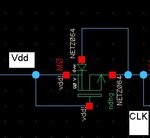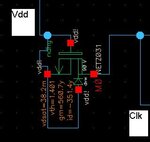shenlufei2005
Newbie level 5
Hello everyone,
I am trapped in the warnings of the simulation under Cadence/Spectre.
Warning from spectre at time = 2.44075 ns during transient analysis `tran'.
WARNING (CMI-2139): M2.m1: The bulk-drain junction current exceeds `imelt'. The results computed by Virtuoso(R) Spectre are now incorrect because the junction current model has been linearized.
WARNING (CMI-2144): M2.m1: The bulk-drain junction current exceeds `imax'.
There are uncountable similar warnings and notices during the simulation of the charge pump. Since the bulk and the source of the nDMOS Switch are connected together, the if the output voltage is higher than the input one, the bulk voltage is inevitably higher than the drain voltage. As the consequences, the bulk drain diode will be turned on and the current will be very dangerous for the device.
However, since nDMOS is widely used as switches now, has anybody ever encountered such problems? Are the warnings and notices (no errors) after the simulation of Spectre/Cadence very important??
Many thanks,
Lufei
I am trapped in the warnings of the simulation under Cadence/Spectre.
Warning from spectre at time = 2.44075 ns during transient analysis `tran'.
WARNING (CMI-2139): M2.m1: The bulk-drain junction current exceeds `imelt'. The results computed by Virtuoso(R) Spectre are now incorrect because the junction current model has been linearized.
WARNING (CMI-2144): M2.m1: The bulk-drain junction current exceeds `imax'.
There are uncountable similar warnings and notices during the simulation of the charge pump. Since the bulk and the source of the nDMOS Switch are connected together, the if the output voltage is higher than the input one, the bulk voltage is inevitably higher than the drain voltage. As the consequences, the bulk drain diode will be turned on and the current will be very dangerous for the device.
However, since nDMOS is widely used as switches now, has anybody ever encountered such problems? Are the warnings and notices (no errors) after the simulation of Spectre/Cadence very important??
Many thanks,
Lufei

